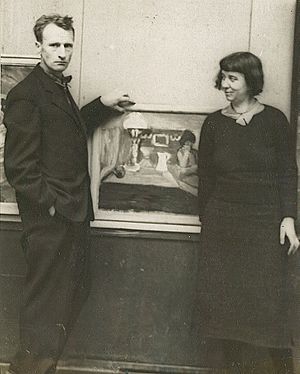Hannah Ryggen facts for kids
Quick facts for kids
Hannah Ryggen
|
|
|---|---|

Hannah Ryggen (right) and Hans Ryggen about 1935-1940
|
|
| Born |
Hannah Jönsson
21 March 1894 Malmö, Sweden
|
| Died | 2 February 1970 (aged 75) Trondheim, Norway
|
| Nationality | Norwegian |
| Occupation | Textile artist |
| Spouse(s) | Hans Ryggen |
| Children | Mona Ryggen-Granholm (1924–2005) |
Hannah Ryggen (born Hannah Jönsson on March 21, 1894, in Malmö, Sweden – died February 2, 1970, in Trondheim, Norway) was a talented textile artist. She was born in Sweden but became Norwegian. Hannah taught herself how to weave.
She used a special loom built by her husband, Hans Ryggen, who was a painter. They lived on a farm near a Norwegian Fjord. Hannah even dyed her own yarn using plants she found nearby.
Contents
Hannah Ryggen's Art Career
Hannah Ryggen was a pacifist, meaning she believed in peace and was against war. She followed news from feminist and leftist groups in Scandinavia. She was also involved in the Norwegian Communist Party and groups that supported workers around the world.
Art Against War and Dictators
Hannah paid close attention to the rise of fascism in Europe. Fascism is a type of government where one powerful leader controls everything, and people have very few rights. She created many artworks that directly showed her feelings about these events.
Unlike some artists who used made-up characters, Hannah showed real historical figures in her tapestries. She focused on leaders who created or supported these harsh governments. These included Mussolini, Hitler, Göring, and Quisling.
Famous Tapestries and Exhibitions
In 1935, Hannah wove a tapestry called 'Etiopia' (Ethiopia). She made it after Mussolini's army invaded the African country of Ethiopia. This powerful artwork was shown at the Paris World's Fair in 1937. It was displayed near Pablo Picasso's famous painting, Guernica.
'Etiopia' was also shown at the New York World's Fair in 1939. However, a part of the tapestry showing a spear going through Mussolini's head was covered up.
In 1936, she created 'Hitlerteppet' (The Hitler Carpet). She also made 'Drømmedød' (Death of Dreams). This tapestry showed prisoners and cruel Nazis in a concentration camp.
Hannah Ryggen created about one hundred large tapestries during her life. Her works mixed realistic images with abstract shapes. She followed the weaving traditions of Norwegian folk art from the 17th and 18th centuries.
Her tapestry 'Henders bruk' from 1949 was very important. It was the first textile artwork bought by the National Gallery of Norway.
International Recognition
In 1962, twenty-eight of her works were shown in a special exhibition. This was at the Moderna Museet in Stockholm. Hannah was also the first Norwegian woman artist to have her work shown at the Venice Biennale in 1964. The Venice Biennale is a very important art exhibition. In 2012, some of her woven pieces were part of dOCUMENTA (13) in Kassel, another major art event.
Where to See Her Art
Hannah Ryggen's art can be found in several important collections:
- National Museum, Oslo, Norway
- National Museum of Decorative Arts and Design, Trondheim, Norway
- County Museum of Gävleborg, Gävle, Sweden

